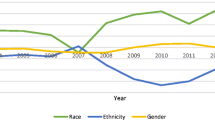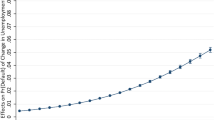Abstract
This paper examines the impact of refinancing on mortgage defaults based on an empirical investigation of the Home Affordable Refinance Program (HARP). We study a unique dataset from Freddie Mac which includes loans funded right before and after the HARP eligibility cutoff date, an exogenous event. Using a Fuzzy Regression Discontinuity Design method, we show that receiving a HARP refinance decreases the expected monthly default rate by about 48–62 percent using different bandwidth specifications.



Similar content being viewed by others
Notes
We found quantitatively similar results when the analysis sample was extended to include other fixed rate and ARM mortgages.
The effect of payment change on default among distressed loans has also been examined, and shows that a 10 % payment reduction leads to about a 8–13 % default rate reduction (e.g., Agarwal et al. (2011) and Haughwout et al. (2009)). See also Scharlemann and Shore (2015) for an analyses of principal reduction’s impact on the default rates of distressed loans.
For interest-only mortgages changes in the interest payment is analogous to the principal and interest payment of a fixed-rate mortgage because it is a portion of the mortgage payment which excludes taxes, insurance, and association fees.
Our research also contributes to the analysis of interventions to reduce mortgage default after the financial crisis (see, for example, Cordell et al. (2009) and Gerardi and Li (2010)) and a broader literature of mortgage default. See, for example, Kau, Keenan and Kim (1994), and Vandell (1995) for an extensive review of the ‘option to default’ literature.
See Barclays Capital, Securitized Products Weekly. 28 Oct 2011, and Securitized Products Weekly. 6 Jan. 2012.
See Nomura, 2011. Securitized Products Weekly, 28 Oct 2011 for more details.
References
Agarwal, S., Amromin, G., Ben-David, I., Chomsisengphet, S., & Evanoff, D. D. (2011). Market-based loss mitigation practices for troubled mortgages following the financial crisis. Chicago: SSRN Working Paper Series.
Campbell, J. Y., & Cocco, J. F. (2015). A model of mortgage default. The Journal of Finance, 70(4), 1495–1554.
Cordell, L., Dynan, K., Lehnert, A., Liang, N., & Mauskopf, E. (2009). Designing loan modifications to address the mortgage crisis and the making home affordable program. Finance and Economic Discussion Series: Federal Reserve Board.
Demyanyk, Y. S., Koijen, R. S. J., & Van Hemert, O. (2011). Determinants and consequences of mortgage default. Unpublished working paper.
Ehrlich, G., & Perry, J. (2015). Do large-scale refinancing programs reduce mortgage defaults? Evidence from a regression discontinuity design: working paper 2015–06 (No. 50871).
Elmer, P. J., & Seelig, S. A. (1999). Insolvency, trigger events, and consumer risk posture in the theory of single-family mortgage default. Journal of Housing Research, 10(1), 1–25.
Elul, R., Souleles, N. S., Chomsisengphet, S., Glennon, D., & Hunt, R. (2010). What ‘triggers’ mortgage default? American Economic Review, 100(2), 490–494.
Fuster, A., & Willen, P. S. (2012). Payment Size, Negative Equity, and Default. Federal Reserve Bank of New York (No. 582). Staff Report.
Gerardi, K., & Li, W. (2010). Mortgage foreclosure prevention efforts. Economic Review-Federal Reserve Bank of Atlanta, 95(2), II.
Hahn, J., Todd, P., & Van der Klaauw, W. (2001). Identification and estimation of treatment effects with a regression-discontinuity design. Econometrica, 69(1), 201–209.
Haughwout, A., Okah, E., & Tracy, J. S. (2009). Second chances: subprime mortgage modification and re-default. FRB of New York Staff Report, 417.
Kau, J. B., Keenan, D. C., & Kim, T. (1994). Default probabilities for mortgages. Journal of Urban Economics, 35, 278–296.
Lee, D. S. (2008). Randomized experiments from non-random selection in U.S. house elections. Journal of Econometrics, 142, 675–697.
Lee, D. S., & Lemieux, T. (2010). Regression discontinuity designs in economics. Journal of Economic Literature, 48, 281–355.
McCrary, J. (2008). Manipulation of the running variable in the regression discontinuity design: a density test. Journal of Econometrics, 142, 698–714.
Scharlemann, T. C., & Shore, S. H. (2015). The Effect of Negative Equity on Mortgage Default: Evidence from HAMP PRA. Office of Financial Research Working Paper, (15–06).
Tracy, J. & Wright, J. (2012) Payment Changes and Default Risk: The Impact of Refinancing on Expected Credit Losses” FRB of New York Staff Report No. 562. Available at SSRN: http://ssrn.com/abstract=2080261 or doi:10.2139/ssrn.2080261
Trochim, W. M. (1984). Research design for program evaluation: the regression-discontinuity approach (Vol, 6). Inc: SAGE Publications.
Vandell, K. (1995). How ruthless is mortgage default? A review and synthesis of the evidence. Journal of Housing Research, 6(2), 245–264.
Zhu, J., Janowiak, J., Ji, L., Karamon, K., & McManus, D. (2015). The effect of mortgage payment reduction on default: evidence from the home affordable refinance program. Real Estate Economics, 43(4), 1035–1054.
Author information
Authors and Affiliations
Corresponding author
Additional information
Any views expressed are solely those of the authors and do not necessarily represent the opinions of Freddie Mac or its Board of Directors and should not be attributed to the Urban Institute, its trustees, or its funders. We thank Edward Golding for suggesting this as a research topic. Any shortcomings are the responsibility of the authors.
Rights and permissions
About this article
Cite this article
Karamon, K., McManus, D. & Zhu, J. Refinance and Mortgage Default: A Regression Discontinuity Analysis of HARP’s Impact on Default Rates. J Real Estate Finan Econ 55, 457–475 (2017). https://doi.org/10.1007/s11146-016-9566-z
Published:
Issue Date:
DOI: https://doi.org/10.1007/s11146-016-9566-z




